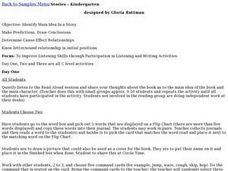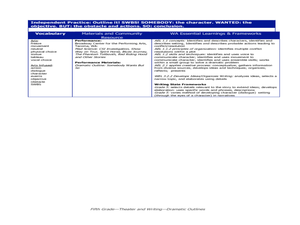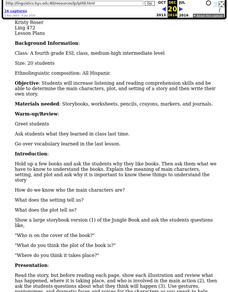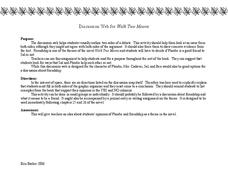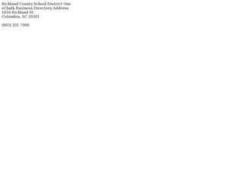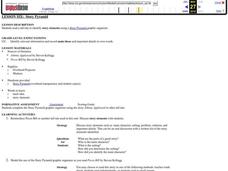Curated OER
Identify Main Idea in a Story
Help your kindergarteners identify the main idea in a story. Small groups work with the teacher to make predictions and draw conclusions. They are able to determine cause and effect relationships. The lesson is divided into several days,...
EdHelper
George Washington's Socks by Elvira Woodruff
A solid, straightforward book report form is an excellent addition to your literature unit. Class members note the main characters, point of view, plot elements, and other important details from a story, adding their favorite part...
EngageNY
Close Reading of The Boy Who Loved Words: How Do People Build Their Word Power?
Third graders practice the skills of identifying the main message in a story, describing the main character, and sorting the key details of a story into specific categories. The story they read is, The Boy Who Loved Words. Using a...
Curriculum Corner
Fiction Graphic Organizers
Get an in-depth look into a narrative text with a three-page worksheet that examines a story's character—actions, sayings, thoughts, and appearance—setting, and challenges scholars to write a brief summary about what they've read.
Curriculum Corner
Summary Writing
Nineteen stylish worksheets offer lesson ideas and practice opportunities designed to reinforce summary skills. Scholars recall events over the weekend as well as favorite books—main characters, problems, solutions, the beginning,...
Curated OER
Dramatic Outlines
Students write about main characters. In this dramatic writing lesson, students brainstorm character ideas. Students create actions and give the character a voice. Students act out the scene in groups and create a final draft.
Curated OER
Nursery Rhymes
Learners recall details of nursery rhyme read by teacher, identify main characters, and demonstrate knowledge of poem by creating concept map about story that includes title, clip art, and changes in font and color.
Curated OER
Language Practice
The simple instructional techniques described in this plan will help young readers learn and practice basic reading skills and strategies. Before reading, introduce your readers to the meaning of main character, setting, and plot. Then...
La Jolla High School
Of Mice and Men by John Steinbeck: Sketching a Portrait--Characterization
John Steinbeck's Of Mice and Men is known for rich character development. Expose your class to indirect characterization and all that it involves with this worksheet. Learners look at quotes, determine what method of characterization is...
Curated OER
Freckle Juice
Students complete activities with the book Freckle Juice by Judy Blume. For this literature lesson, students read chapter one and brainstorm adjectives for the four main characters. They make a page of vocabulary words and...
Syracuse City School District
Literary Elements
Address the literary elements in a piece of writing using these materials. The packet includes plenty of resources, and focuses mainly on theme, character, and point of view, with some materials for setting, symbolism, and author's...
Curated OER
James and the Giant Peach Character Study
Every book has a few great characters, but James and the Giant Peach is the only one whose characters travel in a piece of fruit. The class creates T-charts for the main characters of the novel, while reading the book. They write actions...
Curated OER
Moby Dick Puppetry
Such an ambitious lesson! Third graders with special needs listen to an audio recording of the novel, Moby Dick. They stop often to discuss each of the main characters and analyze their actions in the story. They then make puppets of one...
Curated OER
Walk Two Moons: Discussion Web
Is Phoebe a good friend to Sal or not? After reading chapters twenty-five and twenty-six of Walk Two Moons, class members use the provided graphic organizer to develop an argumentative piece. Writers must decide if the two...
Curriculum Corner
Guest Teacher Plans: Kindergarten
Emergencies happen. Be prepared the next time you have to call in a substitute with a lesson plan designed to meet the needs of a kindergarten class. Throughout the day, class members work with number and alphabet cards, identify numbers...
Roald Dahl
Matilda - Arithmetic
Mr. Wormwood, one of the characters in Roald Dahl's Matilda, is not the most trustworthy of characters. Have student groups take on the roles of car salespeople and play a game to see who can make the most profit by selling...
Florida Center for Reading Research
Comprehension: Narrative Text Structure, Character Consideration
An activity work alongside a narrative text of your choice. With reading comprehension at its focus, readers complete worksheets covering character descriptions.
Curated OER
Chrysanthemum
Students identify the main story elements in the book Chrysanthemum by Kevin Henkes. In this literacy activity, students listen to the book and use a guided reading ball check for comprehension. Students answer questions such as "Who are...
Curated OER
Sorting and Classifying Concrete Objects by Varying Attributes
First graders examine how to sort concrete objects by their attributes. In this sorting lesson, 1st graders listen to Gray Rabbit's Odd One Out by Alan Baker, and discuss the actions of the main character. They practice sorting objects...
Curated OER
Story Pyramid
Learners read tall tales to identify story elements. In this story elements activity, students read about Johnny Appleseed and Pecos Bill and use graphic organizers to record information. Learners read in small groups,...
Curated OER
Because of Winn-Dixie
Students make connections with the book Because of Winn-Dixie through writing. In this writing lesson, students pretend to be the main character and write a letter to her mother, using very descriptive language. Students also...
Curated OER
Rockin' Thad
In this consonant digraph TH worksheet, students help the main character Thad sort ten words into two jars. Students distinguish the difference between a soft TH and a hard TH in ten words.
EngageNY
Close Reading of Thank You, Mr. Falker: Identifying the Superpowers of Reading
Third graders read excepts from the story, Thank You, Mr. Falker in order to gain practice in understanding an unfamiliar story by focusing on the details. They use a worksheet, embedded in the plan, which directs them to certain...
Hawaiʻi State Department of Education
Cinderella
Reading fairy tales is so much fun! Learners use dramatic play to assist them in defining and expressing the main theme found in the story of Cinderella. Each group is given a story card and will create a tableau based on the main point...
